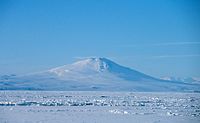
Photo from wikipedia
Abstract The glacier environment in the Namcha Barwa–Gyala Peri (NBGP) massif is regarded as one of the most sensitive areas to climate change, yet the change estimates remain inadequate due… Click to show full abstract
Abstract The glacier environment in the Namcha Barwa–Gyala Peri (NBGP) massif is regarded as one of the most sensitive areas to climate change, yet the change estimates remain inadequate due to the limited knowledge of the complex debris-covered glacier environment and the lack of available remote sensing data caused by continuously cloudy weather. To examine the changes of the complex glacial environment, a multiple hierarchical object- and rule-based classification (MHORC) scheme is proposed by combining Landsat time series images and topographic data. Object-based image analysis (OBIA) is introduced due to its capabilities of handling data contextually and hierarchically and using multi-source data jointly so that multiple hierarchical rule-based classification can be developed to distinguish the objects with similar spectrum such as debris-covered glaciers and their surrounding terrain. All the available Landsat images from 1987 to 2019 are filtered by the cloud cover condition (less than 10%) and accordingly used in the MHORC to obtain spatial and temporal information of the glacier and snow over the NBGP massif. The images collected in the snow-free season are used to estimate the glacier extent state and the historical changes, and those in the snow-covered are used to estimate the snow cover fluctuation using harmonic analysis. The results show that the NBGP contains 65 glaciers (≥0.1 km2) with a total area of 462.7 km2, among which valley glaciers account for 21.5% in number but cover an area of 354.2 km2, more than 76% of the total area. An accelerating reduction trend of the glacier area is confirmed as the area change velocity is −0.62 km2 yr−1 between 1999 and 2003 and reach −2.95 km2 yr−1 between 2003 and 2015. The seasonal snow cover area shows a reduction in the secular trend and an increase in fluctuation amplitude. Both glacier and seasonal snow display heterogeneity in the spatial and temporal patterns. Such heterogeneous dynamics might be related to the trade-off between water vapor supply and regional thermal conditions. This MHORC developed in this study demonstrates its effectiveness in delineating the debris-covered glacier environment and the potential of using Landsat time series to track glacial environment evolution. Besides, the analysis of seasonal snow fluctuations provides a novel perspective to re-recognize the glacial environment dynamics, and the knowledge of glacier extent changes and season snow fluctuations over the NBGP massif can improve the understanding of environmental effects from climate change.
Journal Title: ISPRS Journal of Photogrammetry and Remote Sensing
Year Published: 2021
Link to full text (if available)
Share on Social Media: Sign Up to like & get
recommendations!